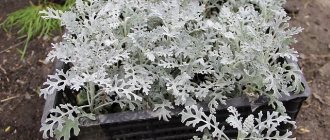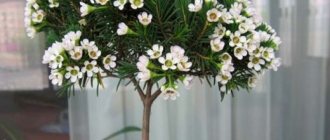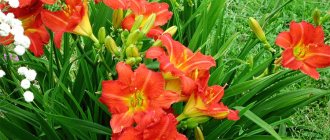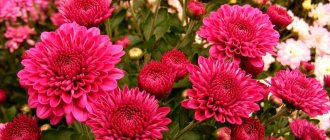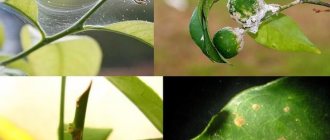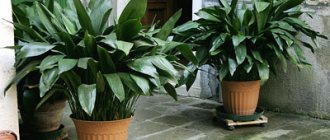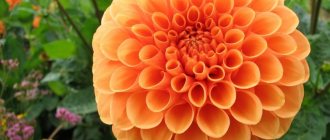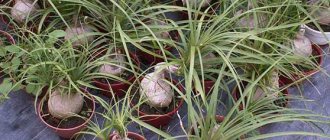Cineraria is a flowering perennial plant that belongs to the Asteraceae family, Asteraceae species. It is often grown in temperate regions of Russia, although the plant is native to South Africa. Summer residents and gardeners fell in love with it for its bright flowers and unusual, grayish-colored foliage. Cineraria leaves no one indifferent; even a novice gardener will be able to care for it. In areas with a temperate climate, ragwort, a flower similar in appearance to cineraria, is also grown.
Main varieties and types of cineraria
Types of cineraria are divided into two large groups: for flowering and for planting as a decorative element. Deciduous varieties are grown in gardens and personal plots, and flowering varieties are suitable for indoor keeping.
The following plant varieties are distinguished:
- Cineraria maritima. It is a silvery perennial that is often used in flower beds and landscaping. Small ash-green bushes look very unusual in combination with bright flowers;
- Cineraria hybrid. A subshrub that is capable of flowering. The inflorescences are described as reminiscent of daisies, petunias or daisies, and the shrub itself grows quite tall, more than 30 cm;
- Cineraria graceful. The stems of this crop are branched and the leaves are slightly lowered. A lot of flowers are formed, literally a whole bunch of them, which will delight you with their bright colors before the onset of cold weather;
- Bloody cineraria. In another way, such a flower is called an indoor flower, since it is ideal for keeping at home on the windowsill. Popular among indoor plant lovers due to its bright flowers and interesting, openwork-shaped leaves. There is no shame in showing such beauty to guests or giving it to loved ones.
Popularly, such a plant is often called “silver dust” or “white dust.”
general information
Cineraria is a herbaceous plant or subshrub, so it is good in landscape compositions. The unusual and sonorous name of the flower is literally translated as “ashy”. This is a tropical guest who came to us straight from the African tropics and Madagascar.
The height of different varieties of cineraria differs several times: from 30 to 90-95 cm. They have branched stems with large leaf plates covered with small edges. Cineraria leaves are oval, lyre-shaped or dissected.
Cineraria has large corymbose inflorescences of all colors of the rainbow from yellow to purple. Large baskets of smooth or terry petals surround a voluminous velvety center. The beauty of flowering will delight you from the beginning of summer until the cold weather. Some species are used when making bouquets and are grown specifically for cutting.
Photo: 2sotki.ru
Growing cineraria from seeds
Those who want to have a silver flower on their plot will have to go to a flower shop for seeds: collecting them yourself is not recommended, as there is a risk that the seed will not take root. Along with the seeds, you will also need to buy containers for planting. It is advisable to do it in early April; you need to take steps step by step and slowly. The seed itself, as a rule, germinates well and quickly. They need to be planted in the surface of the soil; there is no need to bury them deeply. The bud can be compacted with your fingers, moistened with a spray bottle and placed under glass.
Planting and caring for cineraria in open ground
The seedlings sprout quite quickly, in a week or a week and a half. When the stems have 2 leaves and the silver color slowly appears, they can be transplanted into separate pots. In order not to further injure the root system, it is better to transplant small cineraria into peat containers, then there will be no problems with their transfer to open ground. The root system of cineraria is fragile and weak, so you need to be extremely careful and take your time.
Plants should be placed in a well-lit place, or additional artificial lighting should be provided by placing the pots on a stand closer to the light source. If everything is done correctly, the flowers will grow quickly, will soon become stronger, the leaves will become fleshy, and the stem will become strong and stable.
It is better to start replanting into open ground closer to the onset of summer, when frosts will definitely not hit. You need to choose a warm and well-lit place, but also take into account the fact that during the hot lunchtime sun it is best to shade the cineraria. If the plants start to overheat, unsightly brown burns will appear on the leaves. The soil must be enriched with nutrients before planting. The environment suitable for seedlings is neutral, but alkaline is also acceptable.
The transplant itself is also simple, no different from planting any other plants. Holes are dug in advance at a distance of approximately 20 cm from each other to the depth of the peat pots. Plants are placed directly in pots in the holes, the soil is compacted and watered.
Attention! If frost does occur, the plant must be covered or it will die.
If indoor cineraria is chosen, cultivation from seeds is carried out according to the same principle, excluding planting in open ground.
Indoor cineraria - care at home
Being a native of warm countries, the indoor cineraria flower requires good care and proper conditions.
- Air temperature.
Temperature is of great importance for indoor cineraria. She does not like heat, so it is important to keep her cool - no higher than 20°C. Growing at a temperature of 10-15°C is ideal. - Lighting.
Indoor cineraria loves an abundance of sunlight, but it must be diffused - direct rays will not do it any good. - Air humidity.
The flower loves high humidity, but does not tolerate spraying. - The soil.
The ideal substrate for cineraria should consist of 1 part peat and 0.5 parts compost, you can add bark or perlite. The plant does not require fertilizing - this soil contains all the necessary nutrients.
Cineraria - how to water?
Cineraria requires constant soil moisture; watering must be regular. But you should do this carefully - she does not like water getting on the foliage. And remember that over-dried soil and overly wet soil are equally harmful to it. On average, you need to water a flower about once a week at high air humidity, without allowing the soil to dry out. Rain or settled water should be used for this.
Cineraria - transplantation after purchase
Indoor cineraria is often grown as an annual plant and thrown away after flowering, but if you want it to bloom again, you need to replant, which many do immediately after purchase. This can be done in spring or summer, after the end of the flowering period. To do this, drainage is done in the pot, soil is added, and a flower is planted. Weekly after replanting, the plant is fed with universal flower fertilizer. If you bought a flowering cineraria, you should not replant it right away.
What plants are best to plant cineraria next to?
Cineraria is a universal plant, both indoor and outdoor. It can be planted as an independent crop, or can be combined with other flowers.
Looks good on flowerbeds and borders with bright flowers (pink, yellow, red, orange), as well as cold colors (blue, violet, blue, lilac), favorably emphasizing their beauty, while leaving due attention to yourself. It gives the flowerbed aesthetics and completeness, and is not planted just like grass.
With its help, you can even create patterns of varying complexity in flower beds, which can often be seen in city parks and in photos in groups dedicated to floriculture. The silver lawn looks really noble.
Looks good in the design of the lower tiers of multi-story flower beds and decorative borders around the flower bed.
Due to the unpretentiousness of cineraria, you can plant it with any plants and give complete freedom to your imagination. The only thing worth remembering is that neighboring flowers should not shade it too much.
Characteristics and description
Cineraria vulgaris has slightly elongated leaves, which are large in size at the bottom of the stem and become smaller and smaller along the length of the stem.
A distinctive feature of this plant is its spectacular and abundant flowering. Cineraria flowers are clustered in particularly vibrant golden yellow, purple, blue, red, pink and purple flower heads. Sometimes the inflorescences are two-colored.
Among the many varieties of cineraria, there are also dwarf and semi-dwarf varieties, especially suitable for growing in pots. In the photo of cineraria, the jagged leaves look impressive during the non-flowering period, and during flowering the inflorescences completely cover the surface of the plant.
Cineraria maritima has the characteristics of a succulent and is widely used to decorate gardens and terraces due to its ash-gray leaves and silvery down that envelops the stems and leaves. The leaf is also white and silver on both sides and is therefore extremely decorative. It is easy to find on the Black Sea coast.
There are several cineraria hybrids, specially bred to improve their picturesque and decorative characteristics. Of the hybrids, Cineraria cruenta is the most common variety, blooming in shades of blue, pink and blue. It is suitable for pot growing indoors.
Numerous hybridizations have been obtained from this species, including Senecio cruentus, Grandiflora, Multiflora nana and Stellata, so called because of the characteristic star-shaped flower heads.
Features of caring for cineraria
Cineraria requires regular and careful care, in which the following must be taken into account:
- soil features. In order for this beauty to feel as comfortable as possible, the soil is dug up before planting and regular fertilizers are added to it. The leaves do not need to be removed; they will create additional humus when grown. If you have ash or pieces of pine bark on hand, it would also be good to add them to the soil, distributing them evenly;
- temperature regime. Cineraria feels good and blooms when the temperature does not rise above 18 degrees. During sudden warming, the plant must be shaded to prevent damage to the foliage. But she is not afraid of cold temperatures if the temperature drops no lower than 5 degrees;
- if cineraria grows indoors, then it needs to be provided with a constant flow of fresh air, and it is better to move it to more open surfaces such as a terrace or loggia;
- soil and air humidity. Cineraria is a plant that loves moisture, but due to the villi on the foliage, it is not worth spraying, as the leaves may lose their attractiveness. If the flower grows at home, then near it you can place a container with wet pebbles or just a saucer with water. In a garden, you will need to water the soil next to the bushes well. But you can’t over-hydrate the plant, otherwise its roots will rot and it will die. To prevent water from stagnating at the roots, the soil in the flower bed or flower pot must be well loosened;
- cultivation. If the plant is tall, its crown is trimmed using pruning shears. The same is done with wilted or yellowed flower leaves so that they do not draw excess vital juices from the shrub;
- diseases and pests. If transplantation into open ground is carried out incorrectly, then small brown spots can be seen throughout the plant. They occur due to drought. Usually only the lower parts of the plant are affected by drought; the top can be cut off and tried to be rooted. And the old plant will need to be removed from the soil and thrown away; caring for it is useless.
If the leaves begin to wither and dry out for no apparent reason, then most likely the roots of the bush have rotted. Transplantation solves the problem.
Aphids, spider mites, and whiteflies can settle on cineraria, which is why the bush begins to get sick. To prevent this from happening, the flowerbed must be regularly treated from pests and insects.
Caring for indoor cineraria at home is done in the same way.
Plant pests and diseases
This plant rarely gets sick, but all diseases are associated either with improper care or with unfavorable natural conditions. The flower is affected by:
- Powdery mildew - it is easy to notice, as the bush takes on the appearance as if flour had been poured onto it. The disease occurs in the presence of high humidity and is practically not curable on the delicate leaf blades of the plant. Therefore, it is better to remove the infected plant and treat the rest with a fungicide by spraying.
- Late blight - a plant is affected by it if tomatoes or potatoes grow within walking distance of it. At the initial stage of the disease, treating cineraria bushes with copper sulfate will not hurt. And if the lesion is not severe, then it can be sprinkled with wood ash.
- Aphids – sometimes aphids appear on a plant and draw out the juices of the plant, after which it may die. You can fight it by using tobacco or soap tincture. If this does not help, then there are chemicals, such as Fundazol, that can destroy harmful insects that lead to the death of the plant.
Cineraria fertilizer
The plant itself needs good feeding, this is especially true if the soil is poor. A couple of times a month, the soil is sprinkled with mineral fertilizer for flowering plants (sold in gardening stores). When a plant is first planted in open ground, it will need nitrogen fertilizer in order for it to develop lush and voluminous foliage. During the flowering period, the soil is sprinkled with phosphorus fertilizers.
Several times it will be necessary to replace mineral fertilizer with organic matter (manure).
Potted cineraria is fertilized using mineral mixtures for indoor flowers.
Popular types
The Cineraria genus is conventionally divided into 2 groups:
- Decorative foliage. It has silvery flowers and leaves and is usually grown outdoors.
- Decorative blooming. Valued for its dense, voluminous bouquet of flowers, used for room decoration.
One of the common species is silver cineraria. Sometimes it is called graceful ragwort or graceful cineraria, as well as seaside, ashy. The birthplace of culture is the Mediterranean. It has almost white foliage. It is used in landscape design as a border planting. The flowers are small and have no aesthetic value. Some gardeners intentionally remove them at the budding stage.
- Silver dust. Characterized by graceful carved leaves and low growth. Used to create a background for other garden plants.
Silver - Andromeda. A medium-sized species of ashy ragwort up to 40 centimeters high. With age, it changes color from green to silvery white.
- Bloody or hybrid. There are dozens of spectacular hybrids that form a bright bouquet. In most cases, it is grown as an indoor crop, although it was brought to us from the Canary Islands. If planted in open ground, it will grow well as an annual. Retains decorative effect for 2-3 months. Wide range of colors - from soft pink to deep purple.
- Cineraria graceful is another prominent representative of the genus. Although it is inferior to its relatives in terms of decorativeness, it is the most unpretentious plant.
Reproduction of cineraria
Bushes that grow in open ground can be propagated vegetatively, that is, by cuttings. The cuttings are cut small in length, about 10 cm, and grown in a cutting box - a special portable box, which is removed indoors in case of bad weather. The cuttings are made from plywood and boards, and holes are prepared at the bottom for drainage. For propagation by cuttings, drainage is required. Ordinary garden soil is poured onto the bottom, and coarse sifted sand, ideally river sand, is poured onto the top.
Before propagation, the cuttings are dipped in a special product, thanks to which they will take root better in the future. The surface of the soil in the cuttings is leveled and watered with a slightly pink solution of potassium permanganate. Watering is done using a watering can.
The cuttings are placed in a cutting box and covered with cut-off plastic bottles or sour cream glasses. The edge of the dish will need to be slightly driven into the soil, compacted with your fingers. Bottles should not be removed until the plants are completely rooted. Watering is carried out twice a day directly on top of bottles or glasses. If necessary, you can water more often, but do not allow rotting and stagnation of liquid. The soil around future bushes must be loosened with a fork.
Once the plant has taken root, it can begin to be acclimated to the outside environment. To do this, the bottles are removed for 1-2 hours, and as you get used to it, for a longer time. It is advisable to completely remove the protection when it is raining lightly outside. In spring, ashthorn cuttings can be planted in open ground.
For indoor flowers, reproduction is possible only with the help of seeds; they do not reproduce vegetatively.
Watering the plant
Like most plants grown in pots, cineraria does not tolerate stagnant water. You need to wait until the soil is completely dry before watering and make sure the saucer is dry. Moreover, you can use drainage material at the bottom of the flowerpot to facilitate water removal.
As for the choice of soil, all types and varieties of cerenaria love fertile substrates mixed with peat and sand, which make drainage more efficient. There is no need for pruning, just remove wilted or damaged leaves and flowers from time to time. Flowering occurs from April to May, and propagation is by seeds and cuttings.
Cineraria in winter
Cineraria is classified as a perennial plant, but in the climatic conditions of central Russia, the flower overwinters extremely poorly and often freezes, despite diligent care. That is why cineraria began to be grown as an annual rather than a winter plant. With the onset of cold weather, when the plant fades, all vegetation is destroyed and the soil is dug up.
If it’s a pity to part with your pet, then you can replant it in tubs or pots and keep it at home in winter. A room that is as bright as possible, but not too hot, is suitable for keeping. In the spring, the cineraria is again transplanted into open ground, again preparing the soil for planting.
In more southern regions, bushes winter well in open ground; to do this, they need to be wrapped in spruce branches and covered with fallen leaves on top.
Cineraria is a spectacular ash-colored plant that looks like small deer horns; it will not leave anyone indifferent. It looks advantageous both in open ground and when kept at home, so even novice gardeners can safely plant it. The variety of crop varieties allows each person to choose what he likes.
Use in folk medicine
According to folk medicine, this plant has specific decongestant properties for the eyes: it is used in the preparation of eye drops and in the treatment of cataracts.
Senecin (a resinous substance) and sencinine (a very toxic alkaloid) were found in the rhizomes of these plants: for this reason, modern medicine does not recommend its uncontrolled use, only under the supervision and on the recommendation of a competent doctor.
Cineraria, particularly the maritim variety, is a medicinal plant widely used for its soothing, decongestant and anti-inflammatory properties.
In homeopathy, it is a natural remedy used for conjunctivitis, eye inflammation, eye strain and hypersensitivity. Its drops are effective for allergic manifestations, even acute ones, replacing eye medications with cortisol.
